

The tiger king and the stuff the British stole. Universities ignoring own English standards to admit more high-paying international students. Updated about an hour agoMon 6 May 2019, 12:26am Australian universities have been waiving their own English entry standards in a bid to admit more high-paying international students.

Key points Some universities have waived English requirements for international studentsThe body representing education agents in India says international students should take an independent English testAcademics at some universities say they are seeing increasing numbers of academic misconduct cases in some courses It comes as academics have told the ABC's Four Corners program that they are seeing record numbers of academic misconduct cases and increasing numbers of international students who are struggling. Academics have shared stories of foreign students using phone apps to translate university lectures and students in postgraduate IT courses who were unsure how to use a computer or a USB drive.
Visa applications approved 'in minutes' Andrew Durston worked for the Immigration Department for nearly 30 years. Indus Valley. Ancient India - Ancient Civilizations for Kids. 50 or 60 million years ago India slowly smashed into Asia and formed the Himalaya and Hindu Kush Mountains that nearly block off India from the surrounding area.
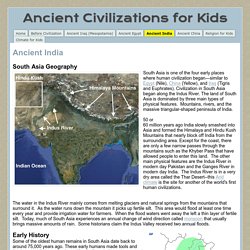
Except for the coast, there are only a few narrow passes through the mountains such as the Khyber Pass that have allowed people to enter this land. History of India for Kids - History Games and Videos. Ancient India - History of India - Quatr.us. Who runs Quatr.us?
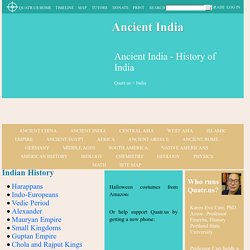
Karen Eva Carr, PhD. Assoc. Professor Emerita, History Portland State University Professor Carr holds a B.A. with high honors from Cornell University in classics and archaeology, and her M.A. and PhD. from the University of Michigan in Classical Art and Archaeology. What are some interesting facts about Indian architecture? Meaning of Ancient Indian Architecture. Ancient Indian Art and Architecture - Important India. The relics of Ancient Indian art and architecture concern predominantly religious themes.
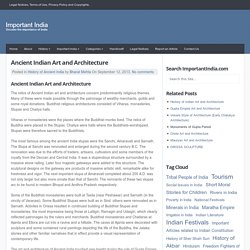
Many of these were made possible through the patronage of wealthy merchants, guilds and some royal donations. Buddhist religious architectures consisted of Viharas, monasteries, Stupas and Chaitya halls. 14 Ancient Architectures of India That Will Make You Proud. Go anywhere, be anyone, do anything, you cannot escape the pride that you feel whenever someone mentions the word ‘India’.
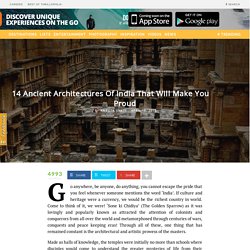
If culture and heritage were a currency, we would be the richest country in world. Come to think of it, we were! 14 Ancient Architectures of India That Will Make You Proud. Architecture of India. అఆఇఈ.

Ancient Indian Architecture - Architecture In Ancient India - Ancient Indian Architectural Styles - Ancient Architecture India. Architecture in ancient India was unique in its style.
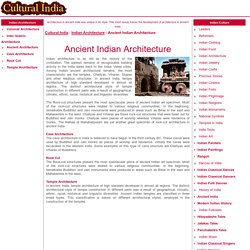
This short essay traces the development of architecture in ancient India. Indian architecture is as old as the history of the civilization. The earliest remains of recognizable building activity in the India dates back to the Indus Valley cities. Among India's ancient architectural remains, the most characteristic are the temples, Chaityas, Viharas, Stupas and other religious structures. Famous Historic Buildings & Archaeological Sites in India – Agra, Taj Mahal, Red Fort, Baby Taj, India Agra Taj Mahal The Taj Mahal is one of the most splendid pieces of architecture in the world.
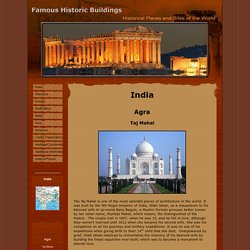
It was built by the 5th Mogul emperor of India, Shah Jahan, as a mausoleum to his beloved wife Ar-ju-mand Banu Begum, a Muslim Persian princess better known by her other name, Mumtaz Mahal, which means, the Distinguished of the Palace. The couple met in 1607, when he was 15, and he fell in love, although they weren't married until 1612 when she became his second wife. The Taj Mahal is in fact an architectural complex and not just the one building. The mausoleum stands on a raised platform (186 feet square) with its four corners truncated, forming an unequal octagon. 10 most amazing ancient rock cut structures in India. The historical rock cut architecture of India is of unprecedented richness and variety.
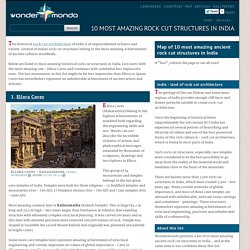
Several of Indian rock cut structures belong to the most amazing achievements of ancient cultures worldwide. Below are listed 10 most amazing historical rock cut structures in India. List starts with the most amazing one - Ellora Caves and continues with somewhat less impressive ones. The last monuments in this list might be far less impressive than Ellora or Ajanta Caves but nevertheless represent an unbelievable achievement of ancient artists and artisans. Make a Clay Seal - Mesopotamia Project - Quatr.us. Cylinder seal and square seal from West Asia The people of ancient Mesopotamia had many baskets which had been sealed with a special mark pressed into a lump of clay.

Government officials marked their property so nobody could steal it. Their neighbors further east in India and west in Greece, from the Early Bronze Age, about 2100 BC, learned to use seals too. You can also make seals and seal things. Harappan Architecture - Ancient Indian Architecture - Quatr.us. Bath building at Mohenjo-Daro, 2500 BC The earliest big buildings in India were built by the Harappan people in the Indus River valley, about 2500 BC.
The Harappan buildings included high brick walls around their cities to keep out enemies. Most of the buildings were ordinary houses, with rooms arranged around a small courtyard. Probably some families owned a whole house (and lived in it with their slaves), while others rented only one room in a house, and the whole family lived together in the one room. Ancient Indian Architecture - History of India - Quatr.us. Rock-cut temples at Ajanta, India The earliest architecture that anyone knows about from India dates to about 2500 BC, in the Harappan period in northern India (modern Pakistan). The Harappans built big cities, with walls around them and public baths and warehouses and paved streets. But when Harappan civilization collapsed, about 2000 BC, almost two thousand years went by before anybody in India built a big stone building again.
When Indian architects did begin to build big buildings again, about 250 BC, at first they built them of wood. Nobody in India knew how to build big stone buildings so they wouldn't fall down. Details. Details. The Stupa. An Introduction to Buddhism. Understanding Buddhism Buddhism has deeply influenced the character and evolution of Asian civilization over the past 2,500 years. It is based on the teachings of a historical figure, Siddhartha Gautama, who lived around the fifth century BCE.
As it moved across Asia, Buddhism absorbed indigenous beliefs and incorporated a wide range of imagery, both local and foreign, into its art and religious practices. Buddhism continues to evolve as a religion in many parts of the world. Buddhism is a complex subject, a philosophy that has evolved in many different ways and various regions of Asia, and is still a living faith today. Providing simple definitions for the beliefs and art historical developments of Buddhism is therefore difficult, because so many variations occur.
History of India for Kids - History Games and Videos. World History Timeline The history and civilization of Ancient India. World History Timeline History of Ancient India and South Asia 200 BC. Syllabus bites exploring Asian texts banner - India. Explore an interactive map of ancient India.5 The geography6 of ancient India was varied, with fertile soils and braiding rivers. Climatic conditions suited agriculture7. Hill land pastures were suitable for grazing animals and hunting in the forest provided another food source. The rivers provided fresh water for crops, drinking and abundant fish. List of Mauryan rulers. Virtual Art Exhibit - The Mauryan Empire. World History Timeline The FREE atlas of world history. Maurya. The Mauryas: Indian dynasty in the fourth-third centuries BCE, which unified the subcontinent for the first time and contributed to the spread of Buddhism.
Alexander In the final weeks of 327 BCE, the Macedonian king Alexander the Great invaded the valley of the river Kabul, and in the next months, he conquered Taxila, defeated the Indian king Porus at the river Hydaspes, and reached the eastern border of the Punjab. He wanted to continue to the kingdom of Magadha in the Lower Ganges valley, but his soldiers refused to go any further, and Alexander was forced to go south. Many Indians now resisted the invaders. Mauryan-Empire. The Story of India - Timeline. Video about Chandragupta Maurya. Google Lat Long: Zoom with a view: Visit India’s stunning monuments online. Ashoka the Great is for real. Transcript. Chandragupta. Maurya Empire. Former Indian imperial dynasty The Maurya Empire was a geographically extensive Iron Age historical power based in Magadha and founded by Chandragupta Maurya which dominated the Indian subcontinent between 322 and 185 BCE.
Ancient India-Mauryan Empire. Ancient India - The British Museum. India-map-rivers. Ancient India - Ancient Civilizations for Kids. Indian history reveals more ancient civilisations. Transcript VOICE-OVERBut Ashoka, after all, didn't live such a very long time ago. By 300BC, well-documented civilisations had been flourishing for thousands of years in China, in Mesopotamia and in Egypt. Sarasvati River. Ancient India, Indus Valley Civilization for Kids and Teachers - Ancient India for Kids. For Kids: In 1922, archaeologists made an exciting discovery, the remains of an ancient city from a previously unknown civilization. They named this city Harappa. Shortly thereafter, and with help from local guides, they found another city from the same civilization. HA- Unit 3 Ancient India. India. India is a country in South Asia whose name comes from the Indus River.